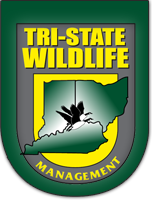Are groundhogs digging in your yard or eating from your garden? For groundhog removal and exclusion, call Tri-State Wildlife Management at (859) 635-0037.
Tri-State Wildlife Management – Protecting You, Your Property, and Your Investment
Alexandria, KY Groundhog Removal (41001): If you have a groundhog problem or have had one in the past year, now is the time to trap groundhogs and remove them. March, followed closely by April, is the best month out of the year to trap groundhogs. Their food supply is limited, they are coming out to sun themselves after a long winter, and their young have not been born. Groundhogs breed in March and April, with a gestation period of 32 days. Young are weaned by late June or early July.
Although pastures and open fields are favorite areas for groundhogs to den, it is not uncommon for them to burrow in urban areas under or alongside the foundation of houses and buildings. The main entrance to their burrow is evident by the pile of soft, powdery dirt next to the entrance. Secondary entrances are sometimes difficult to locate because they lack this pile of dirt. Each opening is about 10 inches in diameter. The groundhog’s range is surprisingly close, averaging 50-150 feet from its den. However, males may travel long distances while looking for a mate, and these males have even been seen traveling at night.
Groundhogs become a nuisance when they excavate next to foundations or under buildings. Their eating habits do not typically conflict with humans; however, gnawing on underground power cables or electric lines causes power outages. The only way homeowners can discourage groundhogs from digging in their yard is to trap and remove all groundhogs in the area.
Groundhogs are found throughout much of the eastern portion of the United States, most of Canada and into Alaska. They enjoy activity during the day, especially warm, sunny afternoons in the spring and fall. They can often be found sunning themselves in an open field, or on a wall or fence. The groundhog has a solid, stocky body and very strong legs. Its front feet have long claws suited for digging burrows. Its fur is very coarse, and mostly brown in color. The groundhog is a member of the squirrel family; however, unlike squirrels, groundhogs fall into a deep state of hibernation during the winter months. Because groundhogs’ eyes, ears, and nose are located toward the top of their head, they can check for danger while remaining in their burrow. Groundhogs are herbivores and favorite foods are grasses (especially alfalfa and clover), vegetables and fruit. They enjoy feeding in the early morning and late afternoon.
Tri-State Wildlife Management is fully insured, and we stand behind all of our work.
Call Tri-State Wildlife Management at (859) 635-0037 for removal and control of groundhogs, moles, skunks, snakes, chipmunks, mice, bats, and more.
Comments are closed.










